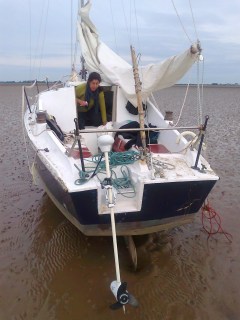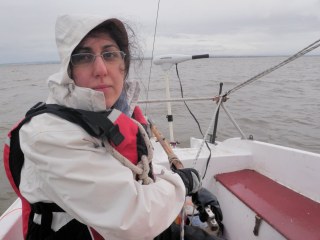A few days sailing off the coast of Bowness-on-Solway took us to the sands of Cardurnock Flatts. The wind died away quite quickly and we were left floating admiring the still currents as they still worked and changed which left the sea silent yet busy. We tried to paddle to the shore by using a kayak oar to skull but we ended up going round in circles, so reluctantly we used the electric motor.which took us to the sands where we dried out. We experienced an amazing mirage… it seemed like the tide was drying out very fast revealing an encroaching sand mass moving our way. We thought we were going to be left high and dry by this sand mass that seemed feet in height and drying out the sea. It turned out to be the ripples on the water as a slight breeze came at last, but the impression was of a sand barrier, very strange.
We dried out on the Flatts for the night admiring the expanse of sand and open sky with an amazing sun set in the evening. Sadaf rested without problems on the sand but a little too into the channel for comfort, a fast tide race would lift us tonight about 12 midnight so we would have to move later into the shore to avoid the anchor dragging. This we did later, but it was still amazing to feel how the power of the channel span us around and moved us fast down tide.
We prepared for the night, 2 people on a boat can always find things to do and there is always things to put away and prepare for the next tide.
On our last day the wind was fresher and Leila took the helm for the first time. She had been crewing for me and she did a good job to get us back to the mooring, but she complained there was not “enough wind”!!!












